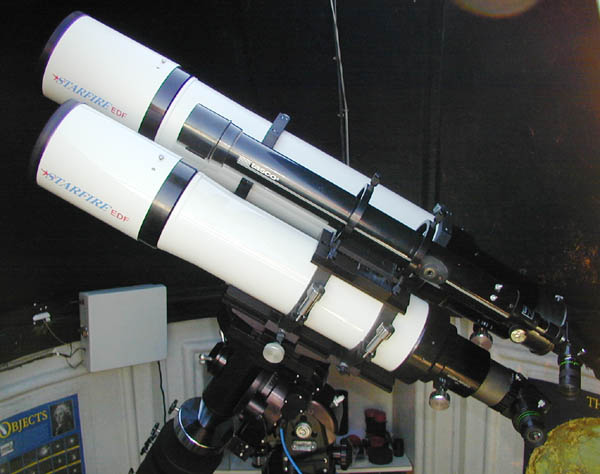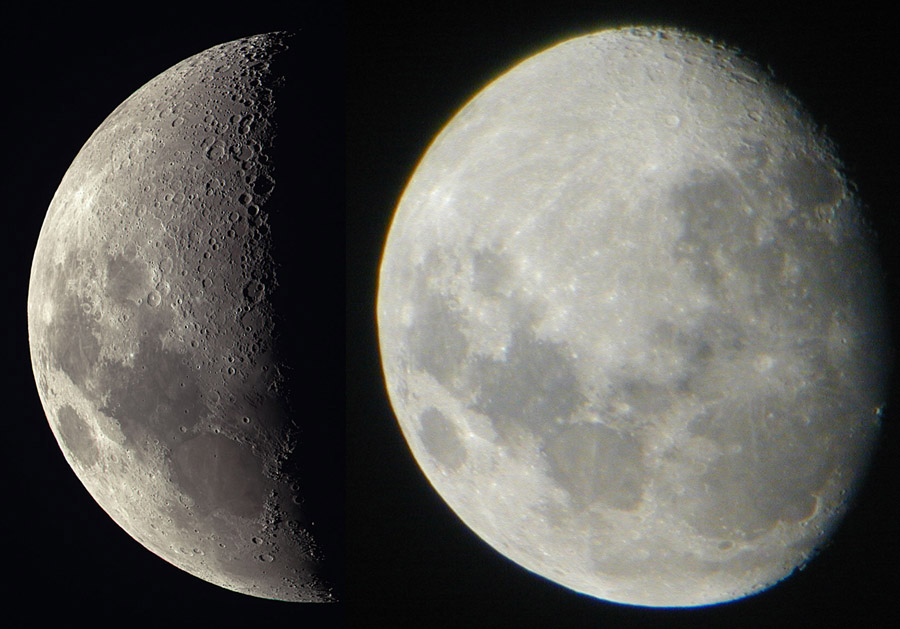On Telescopes
I knew it was going to be tough, but someone had to do it.
The Great Tasco vs Astro-Physics shoot-out J
The two manufacturers specifications are listed below:
|
Tasco Specifications (from their web site) |
Astro-Physics Specifications (from their web site) |
|
MAGNIFICATION:
660x
(!!!) APERTURE: 60mm FOCAL LENGTH: 700mm TELESCOPE TYPE: Refractor MOUNT: Alt-azimuth |
Aperture : 155mm (6.1") Focal length : 1085mm (43") Resolution : 0.74 arc seconds Coatings : Multi-layer, overall transmission greater than 97% in peak visual wavelengths Magnification range : 20x to 600x |
The Tasco spec sheet looked pretty impressive. 660x magnification and it came with its own tripod, 2 barlow lenses and three eyepieces! Tasco are readily available. You can get them from large department stores, better photo-stores, shopping malls, gift stores and garage sales.
Astro-Physics have ridiculously long delivery times, and are only available from a handful of outlets in the inner solar-system. They do come with a nice case including a handsome brass nameplate. No accessories or batteries are included in the price.

Finish and Materials.
The Tasco has a thin rolled metal tube assembly which is finished in gloss black enamel, mild steel and plastic fittings. The focuser drawtube is chrome-plated plastic. Despite having spent 99% of its life indoors, all of the metal fittings on the Tasco had a coating of surface rust after just one night's use outdoors. The matt black interior of the tube assembly had a single spot welded field stop, no knife edges were apparent.
The lens cell was ABS plastic, which was "push fit" onto the metal tube. The lens itself was an air spaced doublet, with magnesium fluoride coatings on the interior air-glass surfaces. A grub screw is used to lock eyepieces in the focuser is somewhat loose and rattled a bit. It was also very effective as an eyepiece barrel engraver if threaded in too tight
The Astro-Physics tube assembly was fully CNC machined, most likely from T6 (aircraft) aluminium. All other fittings were either brass or stainless steel. The tube was finished in an off- white polyurethane. All other fittings were either hard anodized or plated. The oil spaced triplet lens assembly was mounted in a machined and anodized metal cell, which was also fitted with push pull alignment setscrews. Lenses were fully multicoated. Multiple machined knife edge baffles ran the length of the matt black interior of the optical tube. The focus drawtube looked to be hand finished with emery. A brass retaining is fitted to the focuser to prevent marring of eyepiece barrels.
Operation.
The Tasco had 0.96” focuser diameter, which was incompatible with the more common 1.25” standard. A star diagonal with an expansion bushing was used to accommodate larger eyepiece sizes. The supplied Tasco eyepieces had a field of view similar to a drinking straw, the "wide field" eyepiece being 12mm in focal length. The entire set was put to one side for this review.
Despite having a custom alt-azimuth mount included in the price, the Tasco telescope fitted to the Tasco mount was, well not very rigid. My standard flexure test of suspending a 750gram weight from the focuser caused to telescope to rapidly rotate to the zenith and nearly broke the plastic focus tube on the Tasco. It was decided to simply mount both telescopes on a third party mount, (a Losmandy HGM200/Gemini German equatorial) which seemed adequate for both to be tested side by side. The focuser on the AP scope already weighed several kilograms without any additional weight suspended from it, and was totally unaffected by the “750 gram test”.
The Tasco focuser was smooth, but reversing its travel caused a 3-4 arc minute jump in the image. The Astro-Physics was velvety smooth. Image shift on reversing its travel was around 2-3 arc seconds.
The telescopes were allowed to cool down for approximately 2 hours. The star tests were done using a selection of TeleVue eyepieces (7mm, 16mm Naglers, 19mm Panoptic) on both telescopes. Either side of focus the Tasco showed elliptical rings, which shifted through focus around 90 degrees. The airy disk, while visible, stayed in the first diffraction ring until focus was achieved. In focus stars were slightly comet shaped. The first diffraction ring had four bright nodes, in focus stars also having a rainbow like spread. All of this was absent in the Astro-Physics. Stars showed no false colour. Just inside and outside focus patterns were identical. The first diffraction ring was perfectly round and symmetrical.
Turning to the moon, the Tasco showed the a yellow haze near the limb. Craters were visible, but did lack contrast. Even stopped down to 60mm, the Astro-Physics telescope was quite a deal sharper and had significantly better contrast. No yellow haze was no be seen on the limb, which was colourless. With a 7mm Nagler, the Tasco was able to resolve the polar cap on Mars, and comfortably split Alpha Centaurus into two ( rainbow like) dots. Admittedly the eyepiece probably cost more than the telescope, but it also proves a good eyepiece can enhance even a cra....err, modest Telescope. The Astro-Physics resolved Martian ice cap, numerous surface features and then some. Alpha Centaurus looked took on the appearance of tiny searing headlights with lots of black space in between.
An attempt was made to attach a CCD camera to the Tasco. This failed for two reasons, as the camera was not supplied with a 0.96” nosepiece, and its weight (about a kilogram) caused the focuser to sag with the camera attached. A smaller digital camera was used instead. The moon was about the only object that was bright enough to image. A comparison image follows. The AP image is on the left (taken a few days earlier)

Above, the Moon AP155 image on left, Tasco 660x 60mm refractor on right
Conclusion
Tasco's claim of 660x magnification makes one wonder what their marketing people were smoking/sniffing/injecting, maybe all three, at the time….and I found it really hard not to totally lambast the Tasco product for that reason alone, which to be fair, was around 1/100th of the cost of the Astro-Physics tube assembly. Why oh why don't they simply say: Hey, this is a cheap telescope, but lets not set a goal that the instrument will constantly fail to achieve. 20x to 75x is way more realistic. For around $150.00 plus a couple of decent eyepieces, a young person might take the first few steps in what can be a very rewarding hobby, while appreciating the advantages of a finer instrument as their situation allows.
As for the Astro-Physics, well, O.K. this was a bit like cracking a nut with a steam roller. There may be better refractors out there. I just haven’t found them yet.